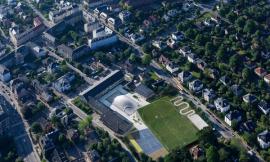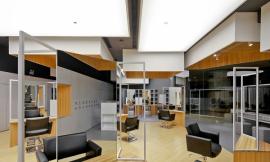来自gmp的分享: 国内外信息技术领域的研究与发展是深圳这座百万人口城市当下的重心。推动IT产业发展的一个核心项目便是“深圳市软件产业基地”,由冯?格康,玛格及合伙人建筑事务所于2009年通过国际竞赛中标并进行了第一标段的规划设计,项目目前已落成。
The focus of the Shenzhen metropolis is on national and international IT research and development. A core project for strengthening the IT industry is the ?Shenzhen Software Industry Base“, for the first plot of which the architects von Gerkan, Marg and Partners won the design commission as part of an international competition in 2009; this has now been completed.

↑ 从西北方向看玻璃幕墙中庭Glazed atria seen from the north-west
这个项目位于南山区西部,比邻香港、宝安国际机场与东部金融中心,地理位置优越。设计首先要结合城市,基地周边充满了研究、管理和服务性建筑,共计18座塔楼。现在这些塔楼则共同围绕着中央一片长向延伸的低矮的建筑群,目前建成的第一标段通过三座塔楼标志了街区在东北侧的开端。
The project is situated in the western Nanshan district and enjoys a favorable strategic location due to its proximity to Hong Kong, the international Bao’An airport and the eastern financial center.
The urban design for the entire precinct, of which the gmp design forms a part, specifies a dense development of research, administration and service buildings comprising a total of 18 towers. These towers are grouped around a spread-out, low-rise development in the center, with the first plot now completed, and with its three towers forming the north-eastern end of the quarter.

↑ 东北侧沿街立面Street view from the north-east
为了实现一个吸引小型IT公司聚集的场所,项目构思上注重对外与对内的交流空间、绿化设计、自然采光与通风。然而基地被道路一分为三的现状阻碍了实现租户之间彼此相连结为整体的愿望。设计解决了这个难题:每一块分割后的基地上都被放置了一座塔楼,裙房则通过桥连接在一起,因此塑造了一个整体体量。交织在一起的长条体块创造了一种动态的构图,体块间的部分则形成了多层的富有变化的中庭,同时为三座塔楼提供了水平面上多层空间的联系。由此通过曲折的建筑体量与之间的桥形成了建筑朝向南北的城市广场,同时也是塔楼的入口空间。
In order to create an attractive, compact location for smaller IT companies, public and internal communication spaces, planted areas, daylight and natural ventilation played a key role in the concept for the project.
The overall intention was to create a coherent complex that links all tenants, but this was hampered by the fact that the site is divided into three parts by roads. The design overcomes this problem by placing one tower on each part of the site and linking the plinths via bridges to create a unified development. The buildings feature a series of bands in the elevations, resulting in a dynamic composition, with the spaces in between forming diverse multi-story atria, while also achieving a horizontal multi-story link between all towers. These meandering building volumes and their bridges create urban squares to the north and south, which also provide the addresses to the towers.

↑ 建筑体量关系Building ensemble

↑ 裙房环绕的内院Courtyards framed by podiums
塔楼容纳了必需的办公面积,综合性的裙房中则布置了其他特殊功能如会议用房、餐馆和小商店,可以从所有塔楼以及街道直接进入。同时五层的屋顶平台可以用作交往空间,联系了几座塔楼。综合体东西侧的两座塔楼分别高90米与100米,通过三层高的天空大堂组织竖向交通,这里也容纳了一些餐厅,开敞的视野越过城市上空直达南深圳湾。
While the towers accommodate the office areas, special functions such as conference areas, restaurants and small shops are located in the linking plinth structure, which can therefore be reached directly from all towers and from street level. In addition, the roof terrace on the 6th floor serves as a meeting point and connection between the different towers. The higher towers in the west and east of the complex, measuring 90 m and 100 m respectively, are topped by three-story sky lobbies, which accommodate additional restaurants and provide a view across the city to the Shenzhen bay to the south.

↑ 作为联系空间的屋顶平台Roof terrace as link element
整齐划一的金属结构立面幕墙包裹了整栋建筑,强化了建筑体量的雕塑感。立面网格由棱柱形的穿孔板构件组成,可以隐藏所有自然与机械通风的开口,因此为办公空间创造了大面积未分割的玻璃幕墙。60厘米进深的幕墙构件同时也为中国南方强烈的阳光直射提供了有效的遮阳。
The fa?ade has been designed as a uniform metallic structure enveloping the buildings and reinforcing the sculptural effect. The grid has been composed of prismatic, perforated metal sheet elements that cover all openings for natural and mechanical ventilation, thus making it possible to provide large, un-divided glazed surfaces to the office areas. The 60 cm-deep fa?ade elements also provide effective solar screening against the intensive solar irradiation prevalent in southern China.

↑ 统一的立面划分Uniform fa?ade structure

↑ 立面结构 & 结合了通风开启扇的穿孔板幕墙单元Fa?ade structure & Perforated fa?ade elements with integrated ventilation flaps

↑ Site plan 总平面图

↑ Layout, FF 首层平面图

↑ Layout, 12th floor
设计:曼哈德·冯·格康和斯特凡·胥茨以及尼古拉斯·博兰克项目负责人:Martin Klingner竞赛阶段设计人员:Philipp Buschmayer, Jochen Sültrup, Amelie Neusen, Xin Meng, Thilo Zehme实施阶段设计人员:陈志聪, 盖旭东, Clemens Ahlgrimm, Anja Menge , Kian LIAN, 徐吉, 何晓华业主:深圳市投资控股有限公司中方合作设计单位:深圳市建筑设计研究院建设周期: 2011–2014年地上建筑面积:111,600 m2地下建筑面积:26,300 m2总建筑面积:137,900 m2建筑高度:塔楼1 60 m塔楼2 90 m塔楼3 100 m获奖:与深圳市建筑设计研究院共同荣获深圳市第十六届优秀工程勘察设计公共建筑类二等奖 Design Meinhard von Gerkan and Stephan Schütz with Nicolas Pomr?nkeCompetition project manager Martin KlingnerCompetition design team Philipp Buschmayer, Jochen Sültrup, Amelie Neusen, Xin Meng, Thilo ZehmeDetailed design project manager Martin KlingnerDetailed design team Zhicong Chen , Xudong GAI, Clemens Ahlgrimm, Anja Menge, Kian LIAN, Ji XU, Xiaohua HeClient SIHC- Shenzhen Investment Holdings CO.,LTDChinese partner practice SADI ShenzhenConstruction period 2011 – 2014GFA above ground 111.600,00 m2GFA below ground 26.300,00 m2Total GFA 137.900,00 m2Height of tower 1 60 mHeight of tower 2 90 mHeight of tower 3 100 mAwards Shenzhen Architecture Design Institute: Award for exemplary buildings in the ?Public buildings“ category, 2nd prize
MORE: gmp
via:gooood.hk |
|

 Flair Salon Designed, Hangzhou, China / atelier mearc
Flair Salon Designed, Hangzhou, China / atelier mearc
